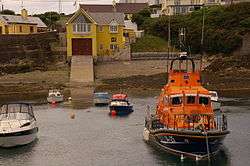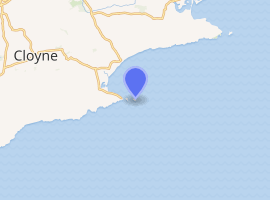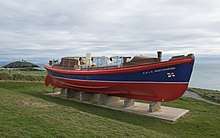Ballycotton
Ballycotton (Irish: Baile Choitín) is a coastal village in County Cork, Ireland, situated about 25 miles (40 km) east of Cork city. It is a fishing village that sits on a rocky ledge overlooking Ballycotton Bay and has a sandy beach that stretches for about 25 kilometres (16 mi) east to Knockadoon Head. The current village is actually a re-settlement of an older village which is now entirely underwater. Ballycotton experiences severe coastal erosion with metres of land crumbling into the sea every few years. It is a site of international research interest on coastal erosion.[5][6]
Ballycotton Baile Choitín | |
|---|---|
Village | |
 Ballycotton lifeboat station dates from 2002. The Trent class boat Austin Lidbury is at its moorings in the harbour. | |
 Ballycotton Location in Ireland | |
| Coordinates: 51°49′37″N 08°00′11″W | |
| Country | Ireland |
| Province | Munster |
| County | County Cork |
| Population (2016)[1] | |
| • Total | 497 |
| Time zone | UTC+0 (WET) |
| • Summer (DST) | UTC-1 (IST (WEST)) |
| Irish Grid Reference | W992640 |
 Ballycotton Lighthouse | |

| |
| Location | County Cork, Ireland |
|---|---|
| Coordinates | 51°49′32″N 7°59′03″W[2] |
| Year first constructed | 1851 |
| Construction | sandstone tower |
| Tower shape | cylindrical tower with balcony and lantern |
| Markings / pattern | black tower |
| Tower height | 15 metres (49 ft) |
| Focal height | 59 metres (194 ft) |
| Range | white: 21 nautical miles (39 km; 24 mi) red: 17 nautical miles (31 km; 20 mi)[3] |
| Characteristic | Fl WR 10s. |
| Admiralty number | A5774 |
| NGA number | 6428 |
| ARLHS number | ARLHS IRE-007 |
| Ireland number | CIL-0290 |
| Managing agent | Commissioners of Irish Lights[4] |
Lifeboat

The RNLI lifeboat station was established in 1858 even though medals had been awarded for rescues that took place in 1826 and 1829. The most famous rescue by the Ballycotton lifeboat took place in 1936. A Gold Medal was awarded to Coxswain Patrick Sliney, Silver Medals to Second Coxswain John Lane Walsh and Motor Mechanic Thomas Sliney, and Bronze Medals to Crew Members Michael Coffey Walsh, John Shea Sliney, William Sliney and Thomas Walsh for the service on 11 February when the Daunt Rock lightship broke away from her moorings. The seas were so mountainous that spray was flying over the lantern of the lighthouse 196 feet (60 m) high. The Barnett-class lifeboat, RNLB Mary Stanford (ON 733) was away from the station for 79 hours and at sea for 49 hours; the crew had no food for 25 hours and they only had three hours sleep. The eight crew were rescued after the lifeboat went alongside the vessel more than a dozen times. This was one of the most exhausting and gallant services in the history of the RNLI.[7]
Lighthouse
Situated on the steep sloped Ballycotton Island approximately 2 km from the village, the lighthouse was commissioned in 1851 when the keeper and his family lived on the island and their children rowed to school weather permitting. By 1899 the four keepers were housed in the town with keepers rotating duty at the lighthouse.[3] In 1975 the light was converted to electricity and it was automated on 28 March 1992 when the lighthouse keepers were withdrawn.[8]
Amenities and tourism
Ballycotton has a number of public houses. There is a pitch and putt course, tennis and squash courts, and beaches nearby. Ballycotton pier and breakwater are used for fishing, with common catches including mackerel, black sole and plaice.
Ballycotton was used as a location for a movie called Divine Rapture during the summer of 1995. Though starring Marlon Brando, Johnny Depp and Debra Winger, the film's production company went bankrupt after just 2 weeks and the movie was never completed.[9]
First run in 1977, the annual Ballycotton Road Race attracted runners from around Ireland and abroad to its 10 Mile circuit of country backroads.[10] The race was routinely over-subscribed. In October 2017 it was announced that the 2017 event was to be the last.[11]
The local area is home to a number of artists and craftspeople included woodworkers, painters, potters, writers and musicians who sometimes exhibit at the Stephen Pearce Gallery in Shanagarry. Ballycotton has a cliff walk extending westward to Ballytrasna. The full walk is about 9 km along a goat-track, with safety fencing where it is needed. Cycling and horse riding are prohibited on the trail. There is bench seating placed at a number of viewing points. The cliff walk is used annually, in March, for a charity walk in support of the Children of Chernobyl. There is also the possibility of spotting Peregrine Falcons near the rocky inlets at dawn and dusk.
Wildlife in the area includes seals and dolphins, and whales are sometimes visible from the cliffs in December and January. The nearby beach at Ballynamona is on a wildlife sanctuary and herons, oystercatchers and sandhoppers.
Ballycotton cross
In 1875 a local antiquarian, Philip T. Gardner, donated the Ballycotton cross (also known as the Ballycottin cross) to the British Museum. It is a 9th-century jewelled Celtic cross with a centre glass jewel with an inscription of the Bismillah in Kufic script[12] which may be interpreted as As God wills, In the name of Allah or We have repented to God. It is held in the British Museum's brooch collection,[13] and the provenance is: "said to have been found in or near Ballycottin Bog". As an early indicator of possible links between Ireland and early Islam, the cross has been cited in academic papers and histories of Islam's presence in Northern Europe in the late Dark Ages, and on speculative history websites and forums.[14]
References
- "Sapmap Area: Settlement Ballycotton". Census 2016. Central Statistics Office. 2016. Retrieved 6 October 2017.
- https://irish.gridreferencefinder.com?gr=X0113663667%7CBallycotton_s_lighthouse%7C1&t=Ballycotton%20lighthouse&v=r
- "Lighthouses - Ballycotton Lighthouse". Commissioners of Irish Lights. Retrieved 6 October 2017.
- Rowlett, Russ. "Lighthouses of Southwestern Ireland (Munster)". The Lighthouse Directory. University of North Carolina at Chapel Hill. Retrieved 10 February 2016.
- "Dáil Éireann - Volume 461 - Adjournment Debate - County Cork Coastal Erosion". Debates record. Oireachtas. 20 February 1996. Archived from the original on 11 February 2012.
- "Sea Level Changes And Ireland". ENFO.ie. Archived from the original on 10 August 2007.
- "RNLI - Ballycotton lighthouse history". RNLI.org.uk. Archived from the original on 23 September 2008.
- "Ballycotton History". Ballycotton Development Company. Archived from the original on 16 May 2008.
- "Brando, Depp, the missing millions and Divine Rapture, the lost movie". The Guardian. 26 November 2009.
- "Ballycotton 10 - Annual 10 mile road race". Ballycottonrunning.com. Retrieved 6 October 2017.
- "Organisers confirm the famed Ballycotton '10' race has come to an end after four decades". The42.ie. 5 October 2017.
- Gilliat-Ray, Sophie (2010). Muslims in Britain: An introduction (PDF). Cambridge University Press. p. 6. ISBN 978-0-521-83006-5.
- "Collection online - brooch / amulet - 1875,1211.1". British Museum. Retrieved 6 October 2017.
- Petersen, Andrew (December 2008). "The archaeology of Islam in Britain: recognition and potential". Antiquity. 082 (318): 1080–1092. doi:10.1017/S0003598X00097799.
External links
| Wikimedia Commons has media related to Ballycotton. |
- Ballycotton Development Company Tourism, sports and local, activities development organisation.
